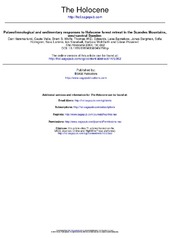| dc.contributor.author | Hammarlund, Dan | eng |
| dc.contributor.author | Velle, Gaute | eng |
| dc.contributor.author | Wolfe, Brent B. | eng |
| dc.contributor.author | Edwards, Thomas W. D. | eng |
| dc.contributor.author | Barnekow, Lena | eng |
| dc.contributor.author | Bergman, Jonas | eng |
| dc.contributor.author | Holmgren, Sofia | eng |
| dc.contributor.author | Lamme, Sara | eng |
| dc.contributor.author | Snowball, Ian | eng |
| dc.contributor.author | Wohlfart, Barbara | eng |
| dc.contributor.author | Possnert, Göran | eng |
| dc.date.accessioned | 2007-12-12T10:36:12Z | |
| dc.date.available | 2007-12-12T10:36:12Z | |
| dc.date.issued | 2004 | eng |
| dc.Published | The Holocene 2004 14 (6): 862-876 | en |
| dc.identifier.issn | 0959-6836 | en_US |
| dc.identifier.uri | https://hdl.handle.net/1956/2494 | |
| dc.description.abstract | A suite of analyses was performed on sediments accumulated during the last 10 700 years in Lake Spaime, a small, hydrologically open water body in the modem alpine tundra zone of the Scandes Mountains, west-central Sweden. The study aimed to evaluate (1) the nature of climate changes that forced the late-Holocene lowering of altitudinal tree limit in the region, the timing of which is known from prior studies based on radiocarbon dating of subfossil wood, and (2) the impact of these vegetational changes on an aquatic ecosystem. Arboreal pollen and plant macrofossil data confirm the persistence of trees in the lake catchment at least from c. 9700 cal. BP until c. 3700 cal. BP. Although growing-season temperature is commonly believed to be the dominant factor driving boreal forest tree-limit variations in the region, a chironomid-based reconstruction of mean July air temperature suggests that local deforestation during the late Holocene was not accompanied by a significant cooling. The tree-limit retreat was more likely caused by increasing effective moisture and declining length of the growing season. The ecohydrological response of Lake Spaime to this combination of climate and vegetational changes included a decline in primary productivity, as indicated by an abrupt decrease in sediment organic matter content, while associated increases in organic 613C, 615N and C/N point to diminished fluxes and altered balance of catchment derived nutrients following deforestation. The decline in aquatic productivity is also marked by a distinct change in the mineral magnetic properties, from a high magnetic concentration assemblage dominated by fine-grained magnetite of biogenic origin to one dominated by background levels of coarse-grained detrital magnetite. | en_US |
| dc.language.iso | eng | eng |
| dc.publisher | SAGE | en_US |
| dc.subject | Holocene palaeoecology | eng |
| dc.subject | Alpine tree-limit dynamics | eng |
| dc.subject | Lake sediments | eng |
| dc.subject | Lacustrine nutrient cycling | eng |
| dc.subject | Stable isotope geochemistry | eng |
| dc.subject | Chironomidae | eng |
| dc.subject | Environmental magnetism | eng |
| dc.subject | Sweden | eng |
| dc.title | Palaeolimnological and sedimentary responses to Holocene forest retreat in the Scandes Mountains, west-central Sweden | en_US |
| dc.type | Peer reviewed | |
| dc.type | Journal article | |
| dc.identifier.doi | https://doi.org/10.1191/0959683604hl756rp | |
| dc.subject.nsi | VDP::Matematikk og Naturvitenskap: 400::Zoologiske og botaniske fag: 480 | nob |
